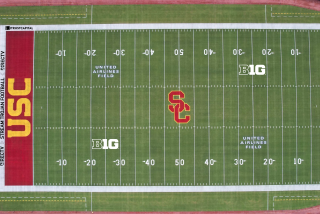Videos-on-Demand Debut on College Campuses : Entertainment: Laser Video Network Inc. has installed kiosks and TVs in 200 dining halls so far.
- Share via
NEW YORK — A 1990s twist on the old jukebox has started showing up on college campuses, but it has more in common with two-way TVs of the future than nickelodeons of the past.
Laser Video Network Inc., a 2-year-old New York company, for the past year has been installing kiosks and TVs to show music videos on college campuses. The setups are in about 200 dining halls so far.
The system, which the company calls College Television Network, is one of the few working examples of video-on-demand, something that has gotten a good deal of hype in the past 18 months.
“The word is so overused at this point,” said Thom Kidrin, president of Laser Video.
Beyond a jukebox, though, the kiosks deliver six commercials an hour, providing an avenue to the hard-to-reach college market that has lured big advertisers such as Coca-Cola, Chevrolet and MCI.
And the interactivity of the machines is more than just choosing the latest video from Counting Crows, Seal or Red Hot Chili Peppers.
A modem into each kiosk allows any user from a student group to the school newspaper to the sporting events ticket office to enter information that is shown amid the videos and commercials.
That ability for viewers to add content is overlooked by many of the big companies testing video-on-demand systems.
At Hunter College in Manhattan, which has one of Laser Video’s first kiosks, the computer only accepts typed messages instead of graphics.
“We used it for lunch specials,” said Ken Farnsworth, the school’s food service director. “We tried to limit who uses it because then you have every school organization wanting to put up a message. We try to have student groups that benefit the entire college as a whole.”
Kidrin said the kiosks being installed this summer will be able to take in and show a five-minute TV newscast produced by a college’s journalism department.
Some schools arrange to show other TV programs at certain parts of the day through the TVs that come with the kiosk. For instance, Michigan State University, which has the Laser Video system in a dining hall serving 1,100, switches the TVs to CNN in the morning and shows its own football, basketball and hockey games when they occur.
“Because we have a cable system hooked in, we have some flexibility with it,” said Bruce Haskell, manager of Wonders Hall at Michigan State. “The predominant use is for the videos as a source of entertainment.”
Students select videos, including comedy clips and movie trailers, using the kiosk’s touch screen. When no selections have been made, the computer plays videos randomly. The biggest kiosks hold 250 videos, which are stored on up to 18 CD-ROM discs.
The company rotates the mix every four to six weeks, taking into account demand for a video. Students who choose Garth Brooks and Mary-Chapin Carpenter often are likely to get a broader selection of country videos, for example.
“We are always trying to stay in sync with where our market is,” Kidrin said.
More to Read
Inside the business of entertainment
The Wide Shot brings you news, analysis and insights on everything from streaming wars to production — and what it all means for the future.
You may occasionally receive promotional content from the Los Angeles Times.










